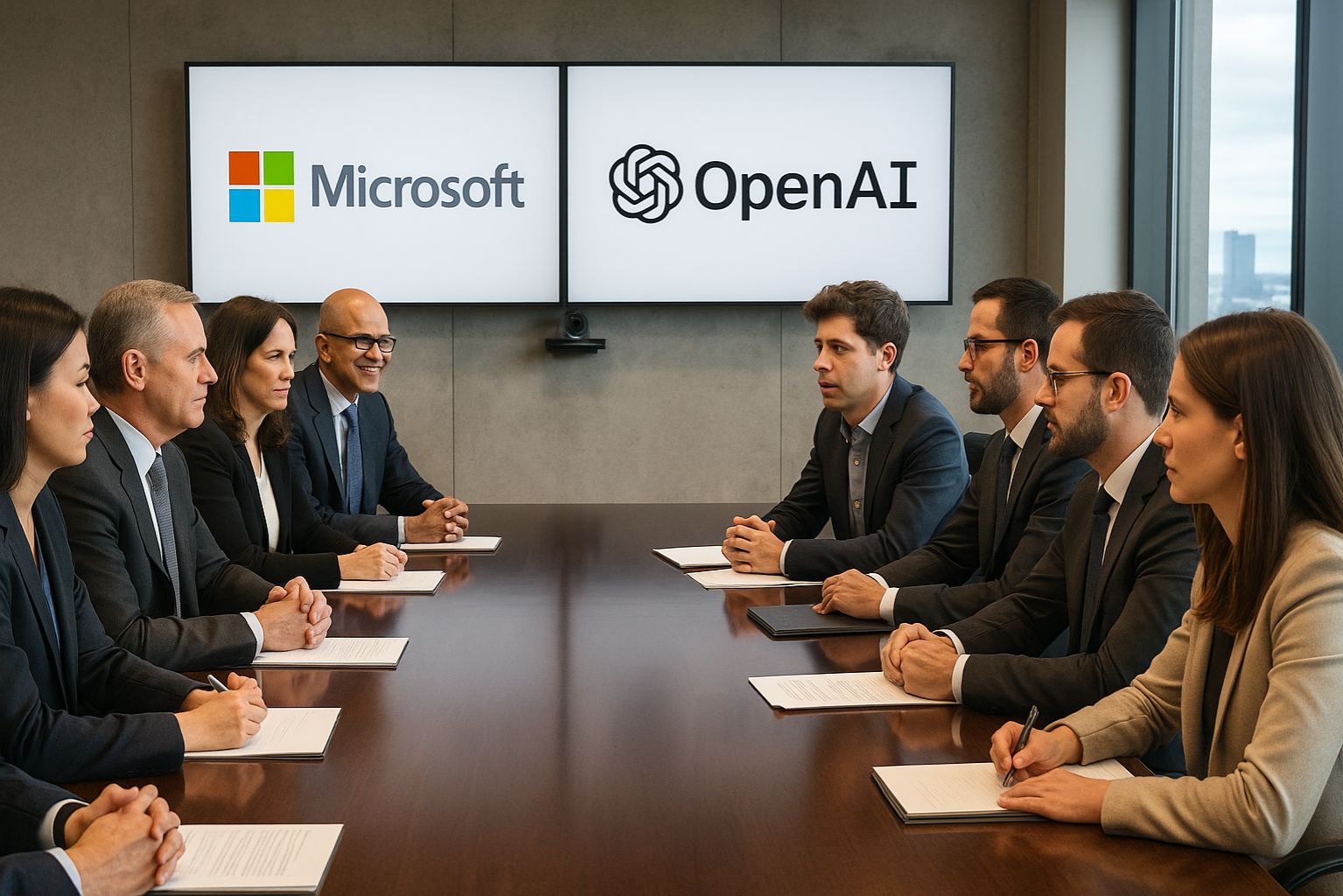
Microsoft CEO Satya Nadella and OpenAI CEO Sam Altman meet with their executive teams to finalize the new partnership agreement, marking a milestone in advancing AI innovation and corporate collaboration. Image Source: ChatGPT-5
Microsoft Deepens $135B Stake as OpenAI Becomes Public-Benefit Corporation
Key Takeaways: Microsoft–OpenAI Partnership Evolves
OpenAI has transitioned its for-profit subsidiary into a public-benefit corporation (PBC), marking a major shift in its corporate structure.
Microsoft now holds an approximately $135 billion stake, representing 27% ownership on an as-converted diluted basis.
The new agreement extends Microsoft’s exclusive IP rights through 2032 and redefines collaboration terms for future Artificial General Intelligence (AGI) development.
OpenAI’s nonprofit parent becomes the OpenAI Foundation, which will commit $25 billion to healthcare and AI resilience initiatives.
The partnership refines independence for both organizations, enabling OpenAI to work with third parties and Microsoft to pursue AGI development independently.
Strategic Agreement Strengthens Long-Term Collaboration
Since their initial 2019 partnership, Microsoft and OpenAI have pursued a shared goal of advancing Artificial Intelligence (AI) responsibly and making it broadly accessible. The companies have now entered a new definitive agreement that strengthens this alliance, setting the stage for continued innovation and long-term success.
Under the new structure, Microsoft supports OpenAI’s formation of a public-benefit corporation and recapitalization, holding an investment valued at approximately $135 billion. The ownership represents roughly 27% of OpenAI Group PBC on an as-converted diluted basis, including employees, investors, and the OpenAI Foundation. Before the recapitalization, Microsoft’s ownership stake in OpenAI’s for-profit subsidiary was approximately 32.5% on a fully diluted basis, excluding the effects of the company’s more recent funding rounds.
This change follows a year of negotiations involving state regulators and investors over OpenAI’s nonprofit status. The conversion resolves those concerns, allowing OpenAI to raise new funding, attract talent, and potentially pave the way for an initial public offering (IPO). The new structure follows nearly a year of discussions with the attorneys general of California and Delaware, whose offices oversee nonprofit governance. OpenAI revised elements of its corporate plan in response to those talks, resolving earlier concerns about its conversion to a public-benefit corporation.
Expanded IP Rights and Clarified AGI Provisions
The renewed partnership keeps the pillars that made the collaboration successful: OpenAI remains Microsoft’s frontier model partner, and Microsoft retains exclusive intellectual property (IP) rights and Azure API exclusivity until the arrival of Artificial General Intelligence (AGI).
At the same time, both companies have introduced a series of new guidelines designed to give each more flexibility for independent innovation while maintaining accountability and shared safety oversight.
Key provisions include:
Independent AGI verification: Any formal declaration of AGI by OpenAI will require review and confirmation by an independent panel of experts, ensuring transparency and shared confidence in such a milestone.
Extended IP timeline: Microsoft’s IP rights covering both models and products now extend through 2032, including any systems developed after AGI is achieved, with additional safety measures in place.
Defined research IP rights: Microsoft’s research-related IP—referring to the confidential methodologies and technical processes used in model development—will stay in effect until either 2030 or until AGI verification, whichever comes first.
Clear scope of research IP: These research rights apply only to internal or experimental models. They do not cover elements such as model architecture, training weights, inference or fine-tuning code, or data-center infrastructure. Microsoft retains non-research IP rights over those components.
Exclusion of consumer hardware: Microsoft’s IP rights no longer extend to OpenAI’s physical consumer hardware products, signaling OpenAI’s growing autonomy in that domain.
Third-party collaborations: OpenAI may now develop select products with external partners. Products that rely on APIs will remain exclusive to Microsoft Azure, while non-API-based offerings can be deployed through other cloud providers.
Independent AGI development: Microsoft can now pursue AGI independently or in partnership with other organizations, reflecting a broader approach to AI advancement.
Compute safeguards: Should Microsoft build AGI using OpenAI’s IP before AGI is formally recognized, those systems will be required to operate within strict compute limits, set far above the capacity of today’s largest training systems, to ensure transparency and responsible resource use.
Revenue-sharing adjustments: The existing revenue-sharing agreement between the two companies will remain active until AGI verification, though payments will be spread over an extended timeline.
Expanded Azure commitments: OpenAI has agreed to purchase an additional $250 billion in Azure cloud services, but Microsoft no longer holds a right of first refusal to be OpenAI’s exclusive compute provider.
Access for U.S. national security clients: OpenAI can now offer API access to U.S. government national security agencies, regardless of which cloud platform they use.
Open-weight model releases: OpenAI is also permitted to release open-weight models, provided they meet predefined capability and safety requirements.
Together, these updates give both companies greater independence and clarity while reinforcing their long-term alignment on safety, transparency, and innovation at the frontier of AI development.
Broader Industry and Market Context
The structural transition has wider implications for the technology industry and investors. The move pushed Microsoft’s valuation above $4 trillion, reflecting strong investor confidence in its AI trajectory. Shares rose roughly 2% on Tuesday as the market reacted to the announcement.
Analysts view this as a natural evolution. According to the Wall Street Journal’s report, “When Microsoft made some of the initial investments, you had no clue just how large and powerful OpenAI was going to be in the software and AI ecosystem,” said Jackson E. Ader, analyst at KeyBanc Capital Markets. “OpenAI wanted to spread its wings eventually. It was natural.”
The new structure also caps years of complex negotiations and internal challenges. OpenAI faced scrutiny following the 2023 firing and reinstatement of CEO Sam Altman, as well as litigation from Elon Musk’s xAI and other critics alleging mission drift from its nonprofit origins.
Meanwhile, Microsoft CEO Satya Nadella emphasized the company’s broader vision of being a platform-driven AI leader. In a recent interview, Nadella said:
“My mindset is all platform. I’m happy with OpenAI. I would love to have Anthropic, [Microsoft AI], Grok—anyone. If Google wants to put Gemini on Azure, please do so.”
Microsoft continues to expand its AI footprint by developing its own models, integrating OpenAI and Anthropic technologies into Microsoft 365 tools, and investing heavily in AI infrastructure. Nadella has recently shifted more of his focus to technical initiatives and data-center expansion.
Q&A: What the Microsoft–OpenAI Agreement Really Means
Q1: What exactly changed in OpenAI’s structure?
A: OpenAI has converted its for-profit arm into a public-benefit corporation (PBC), ensuring it can raise new capital and expand while maintaining a public-interest mission. The OpenAI Foundation—its new nonprofit parent—retains governance oversight and gains ownership in the for-profit worth about $130 billion.
Q2: How does this affect Microsoft’s stake?
A: Microsoft’s investment is now valued at roughly $135 billion, translating to a 27% ownership position on an as-converted basis. That makes Microsoft one of the largest strategic shareholders in the AI sector.
Q3: What’s new about the intellectual-property terms?
A: Microsoft keeps exclusive IP rights and Azure API exclusivity through 2032, even for models created after AGI. However, it no longer has rights over OpenAI’s consumer hardware, and OpenAI can now co-develop products with other partners.
Q4: Why does this matter for AGI?
A: For the first time, AGI status must be verified by an independent expert panel, reducing the chance of unilateral declarations. Both companies can pursue AGI independently, signaling a balanced mix of collaboration and competition in AI’s next frontier.
Q5: How does this shift impact the AI industry overall?
A: The deal pushes Microsoft’s market value beyond $4 trillion and validates AI’s central role in global markets. It also positions OpenAI as both a commercial powerhouse and a mission-driven organization—an unusual hybrid in Silicon Valley’s history.
What This Means: A Defining Moment in AI’s Corporate Evolution
This agreement represents one of the most consequential moments in the corporate history of Artificial Intelligence (AI). It cements Microsoft’s influence in the AI ecosystem while allowing OpenAI to regain autonomy, ensuring both stability and competition within the market.
The formation of the OpenAI Foundation signals a renewed commitment to public benefit, allocating $25 billion toward healthcare and AI resilience initiatives and building on the $50 million fund it previously established to support nonprofit organizations. Together, these efforts reflect an intent to balance commercial growth with social responsibility in AI’s next phase.
As AI innovation accelerates toward AGI, this partnership’s next chapter will shape not only the technology’s development but also how society governs and benefits from it. Both companies now stand poised to define the rules of engagement for AI’s next era.
Editor’s Note: This article was created by Alicia Shapiro, CMO of AiNews.com, with writing, image, and idea-generation support from ChatGPT, an AI assistant used for research and drafting. However, the final perspective and editorial choices are solely Alicia Shapiro’s. Special thanks to ChatGPT for assistance with research and editorial support in crafting this article.
